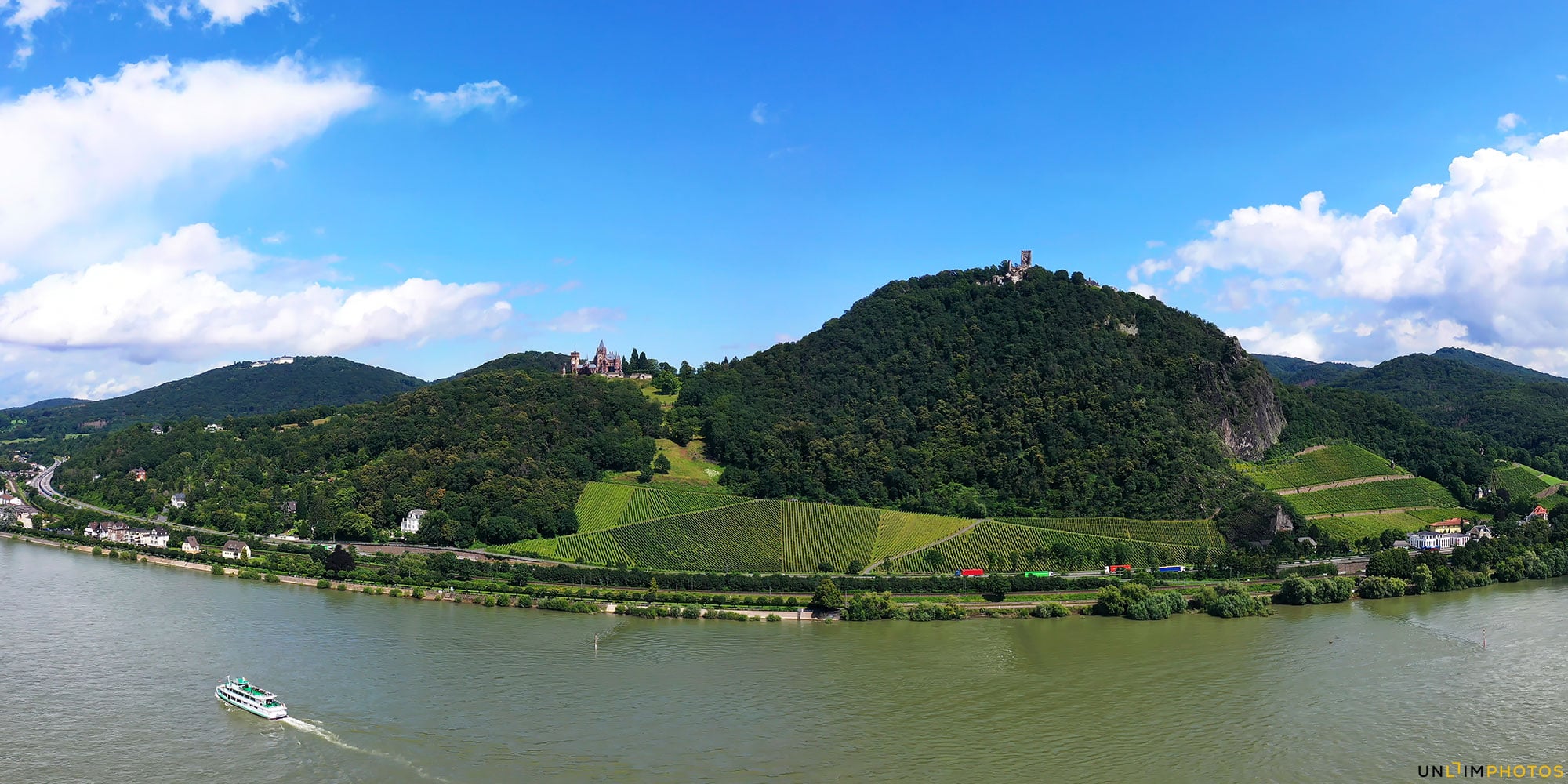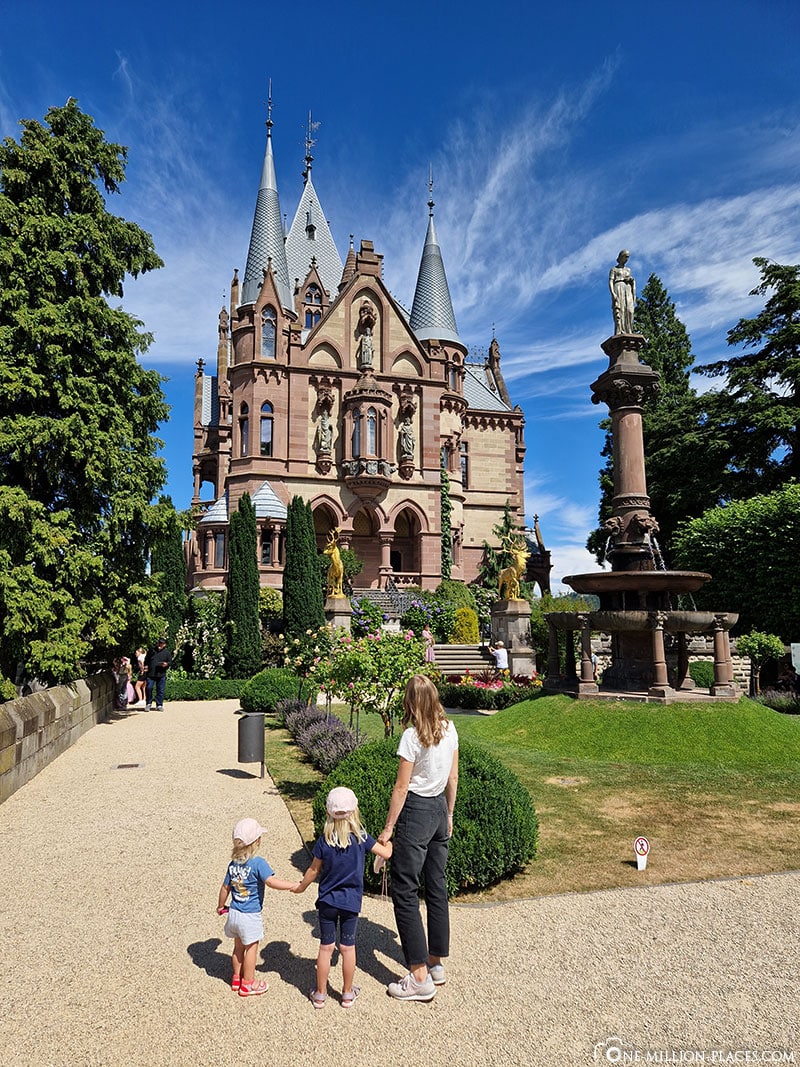On our way to the North Sea for our summer vacation this year, we chose a sightseeing spot from our “Germany bucket list” for a short stopover – the Drachenfels and Drachenburg Castle on the Rhine. We had seen the castle on our river cruise with A-ROSA and were totally impressed. We arrived in Königswinter at around 10 a.m. in perfect summer weather.

Table of contents
The Drachenfels & Drachenfels Castle (Siebengebirge)
The Drachenfels is a striking mountain in the Siebengebirge near Königswinter on the Rhine in North Rhine-Westphalia. At a height of 321 meters, it offers an impressive view over the Rhine Valley as far as Bonn and Cologne. Drachenfels is particularly famous because of its legendary history: according to legend, the hero Siegfried from the Song of the Nibelungs killed the dragon here. On the summit are the ruins of the medieval Drachenburg castle, which was built around 1167 and has been destroyed and restored several times over the centuries.
Drachenburg Castle, a magnificent historicist building from the late 19th century, is located on the slopes of Drachenfels and today serves as a museum and event venue. Visitors can easily reach the summit with the Drachenfelsbahn, Germany’s oldest cog railroad, or on foot via well-maintained hiking trails.
Parking and hiking trails
It is not possible to drive up to Drachenfels Castle or Drachenfels by car, as the plateau and paths are designated as a nature reserve. So you only have the option of taking the Drachenfelsbahn or hiking 🙂
There are 2 hiking trails to the castle and to the summit:
1) The classic route leads via the Eselsweg along the Drachenfelsstraße and takes about 20-30 minutes. The route is steep, but well developed.
2) The somewhat more scenic route through the Nightingale Valley is a little longer and takes about 30-40 minutes. This route is less steep and leads through wooded areas.
However, we didn’t hike, but opted for a ride on the Drachenfelsbahn. We parked our car in the parking lot directly below the valley station (location in Google Maps). Here you will find a good overview of the various parking options and tips for free parking.
The Drachenfelsbahn Königswinter – Germany’s oldest cog railroad
The Drachenfelsbahn was officially opened on July 17, 1883 and has connected the old town of Königswinter in the Rhine Valley with the Drachenfels plateau in the Siebengebirge mountains ever since. Over a length of around 1.5 km, the lift overcomes around 220 meters in altitude and a maximum gradient of up to 20% using the Riggenbach rack and pinion system – a special technical feature of the time. Once operated by steam locomotives, traffic was completely converted to electric railcars between 1953 and the end of the 1950s. The railroad is now one of the busiest cogwheel railroads in Europe: more than 40 million people have used the line since it opened.
The Drachenfelsbahn runs regularly from May to September, daily from 09:00 to 19:00. From October there is a reduced service and between November and February the train only runs at weekends. The exact opening hours can be found on the official website.
The valley station also serves as a tourist information center and museum with changing exhibitions on the history of the railroad. A trip from the valley station to Drachenfels takes around eight minutes and usually runs every 30 minutes (up to every 15 minutes if demand is high). Incidentally, we were able to take our baby carriage with us without any problems.
The middle station of the Drachenfelsbahn
We got off first at the middle station of the Drachenfelsbahn and walked directly to the entrance of Schloss Drachenfels. However, we were there a little too early, as the castle only opens at 11 am, even in summer. You can see the current opening times here.
Interesting facts about Drachenburg Castle
Drachenburg Castle was built between 1882 and 1884 halfway up the Drachenfels near Königswinter and is one of the most unusual castle buildings of the 19th century in Germany. It was commissioned by the wealthy stockbroker Stephan von Sarter, who never lived in the castle himself. Architecturally, the building is an impressive example of historicism: a mixture of Gothic, Renaissance and Baroque, with numerous towers, battlements and rich façade decorations. Today, Drachenburg Castle is considered a cultural monument of national importance and has been extensively restored after a long period of decay and various uses.
Admission to the castle costs EUR 10 for adults and EUR 8 for children (aged 6 and over). There are also special family tickets for 25 EUR (2 adults + max. 2 children). For us, the castle is one of the most beautiful (small) castles 🙂
Tour of Drachenburg Castle
Today, the castle houses a museum open to the public with changing exhibitions, a faithfully reconstructed interior and a panorama salon with a view over the Rhine Valley. Particularly worth seeing are the magnificent music room, the historic study and the artistically painted walls and ceilings.
In contrast to the exterior view, we were not particularly impressed by the rooms of the castle. We have already visited more beautiful castles 😉
The Drachenfels
After visiting Drachenburg Castle, we took a short ride on the Drachenfeldbahn to Drachenfels.
At 321 meters high, the Drachenfels is one of the most famous mountains in the Siebengebirge. It was formed around 25 million years ago by volcanic activity and consists mainly of trachyte rock, which was quarried for centuries – including for Cologne Cathedral. Drachenfels is historically significant because of the ruins of Drachenfels Castle, which was built around 1167 to control the Rhine Valley militarily. The mountain is closely associated with the Nibelungen saga: According to legend, Siegfried is said to have slain the dragon here – hence the name.
On the plateau there is a viewing platform with a panoramic view over the Rhine Valley as far as Cologne and Bonn, as well as a visitor center with restaurants. The Drachenfels is part of the Siebengebirge Nature Park and is subject to strict landscape and nature conservation.
We briefly enjoyed the view of the Rhine and made a short detour to the Drachenfels castle ruins. After an hour, we took the Drachenfelsbahn back down into the valley and continued our journey to the North Sea.


